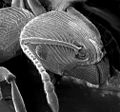Barnacle (section Nauplius larva)
distinct larval stages, the nauplius and the cyprid, before developing into a mature adult. A fertilised egg hatches into a nauplius: a one-eyed larva comprising...
49 KB (4,705 words) - 02:20, 14 August 2024
they are exposed to water. Once the eggs are in water, they hatch into nauplius larvae, which eventually develop into adult Sea-Monkeys. The entire life...
9 KB (1,026 words) - 19:39, 4 September 2024
of biramous (two-parted) limbs, and by their larval forms, such as the nauplius stage of branchiopods and copepods. Most crustaceans are free-living aquatic...
57 KB (4,882 words) - 07:00, 10 September 2024
water-breathers with extendable jaws. Crustaceans commonly hatch as tiny nauplius larvae that have only three segments and pairs of appendages. Insect species...
39 KB (4,860 words) - 19:30, 4 September 2024
Cyclops (copepod) (section Biological)
weakening disease. Cyclops can be controlled using physical, chemical, biological and engineering methods. Straining of water through piece of fine cloth...
30 KB (2,457 words) - 15:32, 27 May 2024
dries up. Eggs hatch into nauplius larvae, which consist of a head with a small tail, but no thorax or true abdomen. The nauplius moults five or six times...
39 KB (4,284 words) - 13:02, 12 April 2024
Allopetrolisthes spinifrons (Crustacea: Decapoda: Porcellanidae)" (PDF). Nauplius. 18 (1): 95–102. Archived from the original (PDF) on 2012-04-25. Tsang...
20 KB (2,097 words) - 13:11, 14 September 2024
Allopetrolisthes spinifrons (Crustacea: Decapoda: Porcellanidae)" (PDF). Nauplius. 18 (1): 95–102. Archived from the original (PDF) on 2012-04-25. Nelson...
5 KB (448 words) - 17:12, 31 January 2022
of a beached humpback whale. Immediately after hatching, the newly born nauplius larvae molted and, after six molts, reached the cyprid stage, the last...
29 KB (3,266 words) - 16:05, 25 August 2024
depths around 2,000–3,000 metres (6,600–9,800 ft). The egg hatches as a nauplius larva; once this has moulted into a metanauplius, the young animal starts...
40 KB (4,472 words) - 18:11, 8 August 2024
to protect both territory and young. Larva develop in three stages: The nauplius larvae, zoea, and post larval stages. More than 620 species are currently...
17 KB (1,821 words) - 02:58, 24 August 2024
Once placed in briny (salt) water, the eggs hatch within a few hours. The nauplius larvae are less than 0.4 mm in length when they first hatch. Parthenogenesis...
29 KB (3,164 words) - 18:34, 30 July 2024
sessile suspension feeders with two active swimming larval stages, the nauplius and the cyprid. The order Pedunculata includes barnacles attached to the...
12 KB (1,353 words) - 23:03, 25 December 2021
infralittoralis and Cytherella sordida, have been found to both possess a nauplius eye too. A new method is in development called mutual ostracod temperature...
37 KB (4,009 words) - 21:40, 9 September 2024
of larval forms". Philosophical Transactions of the Royal Society B: Biological Sciences. 363 (1496): 1473–1479. doi:10.1098/rstb.2007.2237. ISSN 0962-8436...
15 KB (1,347 words) - 12:16, 6 August 2024
species to species. After krill hatch, they experience several larval stages—nauplius, pseudometanauplius, metanauplius, calyptopsis, and furcilia, each of which...
66 KB (6,431 words) - 04:45, 27 August 2024
particles into the shell for consumption. Eggs are laid and develop into nauplius larvae which are released into the phytoplankton. These then develop into...
6 KB (593 words) - 15:25, 3 February 2022
water-breathers with extendable jaws. Crustaceans commonly hatch as tiny nauplius larvae that have only three segments and pairs of appendages. Based on...
131 KB (12,443 words) - 13:27, 11 September 2024
antennae in crustaceans. Many crustaceans have a mobile larval stage called a nauplius, which is characterized by its use of antennae for swimming. Barnacles...
20 KB (2,130 words) - 17:13, 1 June 2024
femininize males the most. Sacculina carcini can be considered as a potential biological control agent for Carcinus maenas, known as the invasive green crab species...
12 KB (1,183 words) - 12:16, 18 February 2024
clam shrimp), the antennae are used for locomotion, as they are in the nauplius. Male fairy shrimp have an enlarged pair of antennae with which they grasp...
20 KB (1,941 words) - 14:10, 9 September 2024
to how the ideas of Garstang's predecessors profoundly influenced his biological theories. Walter Garstang was born on 9 February 1868 as the eldest son...
21 KB (2,161 words) - 13:37, 14 August 2024
offspring also hatch directly into fully developed cyprids instead of nauplius larvae (except for a few species of kentrogonid rhizocephalans, which hatch...
17 KB (1,896 words) - 11:36, 16 July 2024
often die during their first molt. Many development complexities in the nauplius occurred such as malformed thoraxes, growing two abdomina, or short limbs...
10 KB (1,204 words) - 13:10, 11 April 2024
are developing, the adult barnacle does not moult. The eggs hatch into nauplius larvae, which have three pairs of legs, one pair of antennae and a single...
11 KB (1,137 words) - 16:58, 7 January 2024
young animals may be totally different from older phases, such as the nauplius larvae of crustaceans, the nymphs of say, the Odonata, or the larvae of...
19 KB (2,141 words) - 06:23, 29 June 2024
024 in) long. At 5 °C (41 °F), the nauplius 1 stage lasts about 52 hours, and about 9 hours at 15 °C (59 °F). Nauplius 2 takes 170 hours and 36 hours at...
28 KB (3,291 words) - 00:07, 18 August 2024
that is about 10 times faster than the average translation speed of the nauplius. More efficient feeding is a result of this clever adaptation. Adult T...
19 KB (2,360 words) - 07:42, 19 May 2024
second prototype in field trials. Seen here deploying from the 6 m R/V Nauplius (upper left), on the seabed though locked in the up position (upper right...
62 KB (8,663 words) - 17:47, 8 November 2021
"Records of parasitic copepods of sharks from the southwestern Atlantic". Nauplius. 4: 179–180. Knoff, M.; S.C. de Sao Clemente; R.M. Pinto & D.C. Gomes (July...
22 KB (2,679 words) - 21:15, 1 July 2024


























